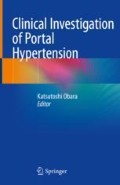Abstract
Bleeding from ruptured esophagogastric varices is the main complication of portal hypertension and a major cause of death. The risk factors of variceal bleeding have been reported but are still debated. Variceal hemorrhage can be caused by various factors including topical, portal hemodynamic, and systemic factors.
A hepatic vein pressure gradient (HVPG) of 10–12 mmHg is required for the development of varices. Furthermore, an HVPG > 12 mmHg is necessary for the occurrence of variceal hemorrhage. Factors that further increase variceal wall tension causing it to reach a threshold and develop a topical mucosal disorder of varices may induce variceal hemorrhage. Considering these factors, management of esophagogastric varices must be performed.
Access this chapter
Tax calculation will be finalised at checkout
Purchases are for personal use only
References
Japanese Research Society for Portal Hypertension. The general rules for recording endoscopic findings on esophageal varices. Jpn J Surg. 1980;10:84–7.
Beppu K, Inokuchi K, Koyanagi N, Nakayama S, Sakata H, Kitano S, et al. Prediction of variceal hemorrhage by esophageal endoscopy. Gastrointest Endosc. 1981;27:213–8.
The North Italian Endoscopic Club for the Study and Treatment of Esophageal Varices. Prediction of the first variceal hemorrhage in patients with cirrhosis of the liver and esophageal varices. A prospective multicenter study. N Engl J Med. 1988;319:983–9.
Kim T, Shijo H, Kokawa H, Tokumitsu H, Kubara K, Ota K, et al. Risk factors for hemorrhage from gastric fundal varices. Hepatology. 1997;25:307–12.
Arakawa M, Kage M. The Anatomy and pathomorphology of esophageal varices. In: Okuda K, editor. Portal hypertension. Tokyo: Springer; 1991. p. 415–28.
Hidaka H, Nakazawa T, Wang G, Kokubu S, Minamino T, Takada J, et al. Long-term administration of PPI reduces treatment failures after esophageal variceal band ligation: a randomized, controlled trial. J Gastroenterol. 2012;47:118–26.
Sakamoto Y, Oho K, Toyonaga A, Kumamoto M, Haruta T, Inoue H, et al. Effect of Helicobacter pylori infection on esophagogastric variceal bleeding in patients with liver cirrhosis and portal hypertension. J Gastroenterol Hepatol. 2013;28:1444–9.
Iijima K, Sekine H, Koike T, Imatani A, Ohara S, Shimosegawa T. Serum pepsinogen concentrations as a measure of gastric acid secretion in Helicobacter pylori-negative and -positive Japanese subjects. J Gastroenterol. 2005;40:938–44.
Ledinghen VD, Heresbach D, Fourdan O, Bernard P, Liebaert-Bories M, Nousbaum J, et al. Anti-inflammatory drugs and variceal bleeding: a case-control study. Gut. 1999;44:270–3.
Yoshida H, Mamada Y, Taniai N, Mineta S, Kawano Y, Mizuguchi Y, et al. Interactions between anti-ulcer drugs and non-steroidal anti-inflammatory drugs in cirrhotic patients with bleeding esophagogastric varices. Hepatogastroenterology. 2009;56:1366–70.
Garcia-Tsao G, Groszmann RJ, Fisher RL, Conn HO, Atterbury CE, Glickman M. Portal pressure, presence of gastroesophageal varices and variceal bleeding. Hepatology. 1985;5:419–24.
Iwao T, Toyonaga A, Sumino M, Takagi K, Oho K, Sakaki M, et al. Development of gastroesophageal varices and risk of variceal bleeding in patients with cirrhosis. Dig Endosc. 1991;3:485–90.
Tripathi D, Therapondos G, Jackson E, Redhead DN, Hayes PC. The role of the transjugular intrahepatic portosystemic stent shunt (TIPSS) in the management of bleeding gastric varices: clinical and haemodynamic correlations. Gut. 2002;51:270–4.
García-Pagán JC, Feu F, Castells A, Luca A, Hermida RC, Rivera F, et al. Circadian variations of portal pressure and variceal hemorrhage in patients with cirrhosis. Hepatology. 1994;9:595–601.
Iwao T, Oho K, Sakai T, Sato M, Nakano R, Yamawaki M, et al. Upright posture decreases esophageal varices blood flow velocity in patients with cirrhosis. J Hepatol. 1998;28:447–53.
Iwao T, Oho K, Nakano R, Yamawaki M, Sakai T, Sato M, et al. Upright posture blunts postprandial splanchnic hyperemia in patients with cirrhosis and portal hypertension. J Gastroenterol. 1999;34:359–65.
Polio J, Groszmann RJ. Hemodynamic factors involved in the development and rupture of esophageal varices: a pathophysiologic approach to treatment. Semin Liver Dis. 1986;96:318–31.
Rigau J, Bosch J, Bordas JM, Navasa M, Mastair R, Kravetz D, et al. Endoscopic measurement of variceal pressure in cirrhosis: correlation with portal pressure and variceal hemorrhage. Gastroenterology. 1989;96:873–80.
Kleber G, Sauerbruch T, Fischer G, Paumgartner G. Pressure of intraoesophageal varices assessed by fine needle puncture: its relation to endoscopic signs and severity of liver disease in patients with cirrhosis. Gut. 1989;30:228–32.
Luca A, Cirera I, Garcia-Pagan JC, Feu F, Pizcueta P, Bosch J, et al. Hemodynamic effects of acute changes in intra-abdominal pressure in patients with cirrhosis. Gastroenterology. 1993;104:222–7.
Kravetz D, Bildzola M, Argonz J, Romero G, Korula J, Munoz A, et al. Patients with ascites have higher variceal pressure and wall tension than patients without ascites. Am J Gastroenterol. 2000;95:1770–5.
Kravetz D, Romero G, Argonz J, Guevara M, Suarez A, Abecasis R, et al. Total volume paracentesis decreases variceal pressure, size, and variceal wall tension in cirrhotic patients. Hepatology. 1997;25:59–62.
Goulis J, Armonis A, Patch D, Sabin C, Greenslade L, Burroughs AK. Bacterial infection is independently associated with failure to control bleeding in cirrhotic patients with gastrointestinal hemorrhage. Hepatology. 1998;27:1207–12.
Author information
Authors and Affiliations
Corresponding author
Editor information
Editors and Affiliations
Rights and permissions
Copyright information
© 2019 Springer Nature Singapore Pte Ltd.
About this chapter
Cite this chapter
Oho, K. (2019). Mechanism and Pathophysiology of Bleeding from Esophagogastric Varices. In: Obara, K. (eds) Clinical Investigation of Portal Hypertension. Springer, Singapore. https://doi.org/10.1007/978-981-10-7425-7_6
Download citation
DOI: https://doi.org/10.1007/978-981-10-7425-7_6
Published:
Publisher Name: Springer, Singapore
Print ISBN: 978-981-10-7424-0
Online ISBN: 978-981-10-7425-7
eBook Packages: MedicineMedicine (R0)

